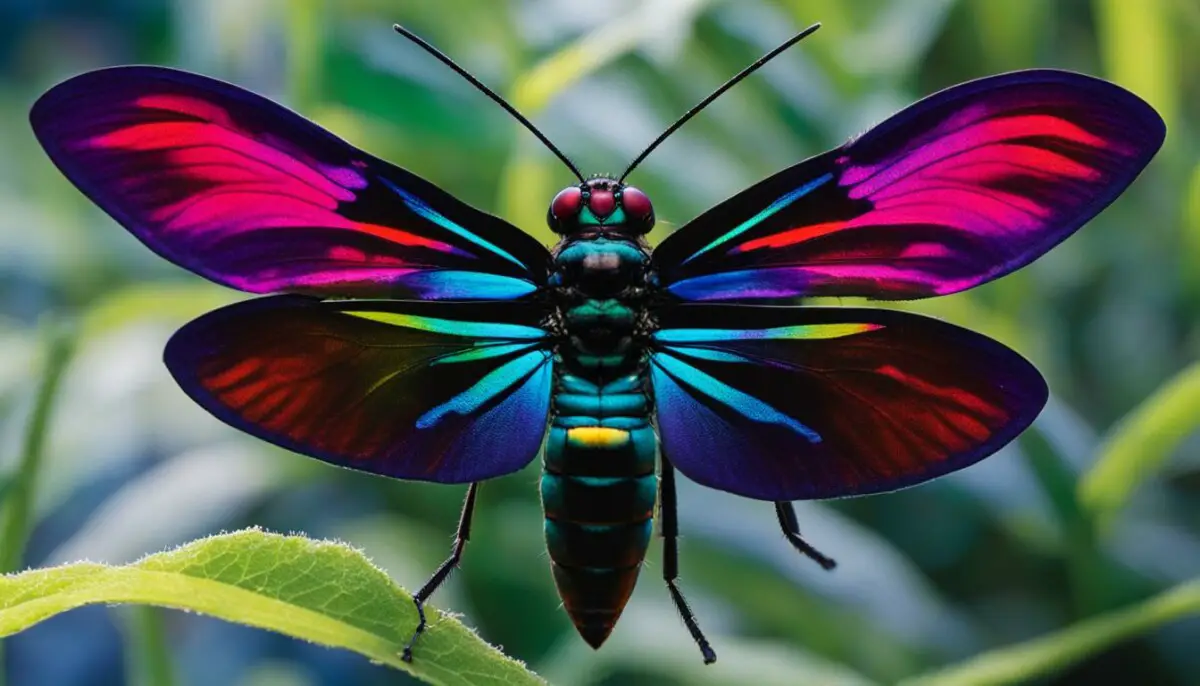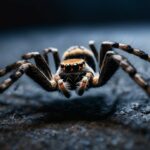Last Updated on 5 months by Francis
Welcome to our fascinating exploration of insect vision capabilities! Insects play a vital role in our ecosystem, and understanding their visual senses is crucial for various fields, from biodiversity conservation to crop production and disease control. One intriguing question that arises is whether bugs can see infrared light. In this article, we delve into the topic and uncover the intriguing world of insect vision.
Contents
Key Takeaways:
- Insects have complex visual systems with compound eyes consisting of individual lenses called ommatidia.
- While insects do not have true infrared vision, some can perceive and respond to thermal radiation.
- Infrared cues play a significant role in insect behavior, guiding activities such as foraging, mating, and seeking shelter.
- Insects have specialized thermoreceptors that help them detect changes in temperature and locate warm environments.
- Artificial lights, including security cameras, can attract insects, causing interference and blurry footage.
Understanding Insect Vision
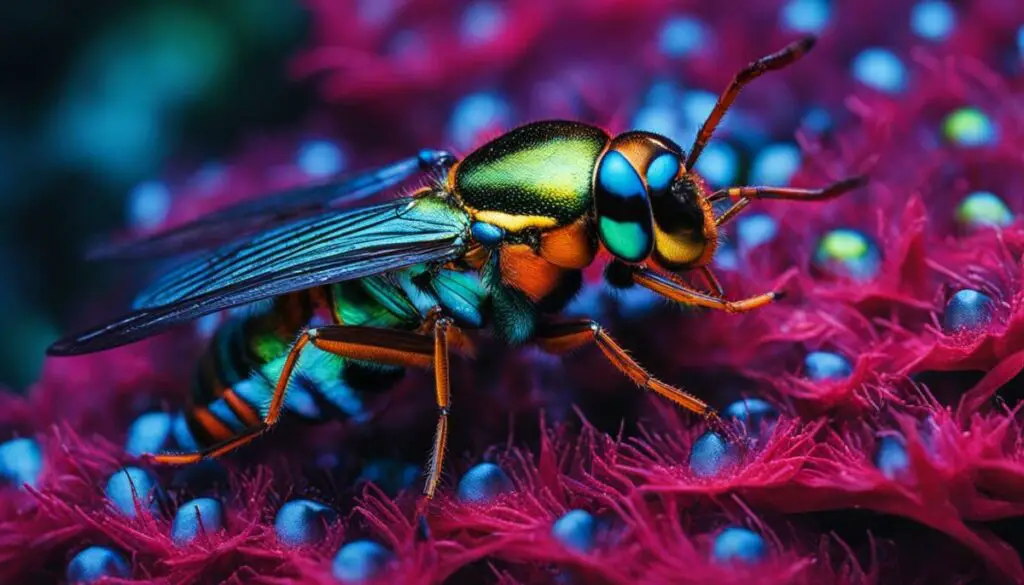
Insects have fascinating visual capabilities that allow them to navigate their environment with precision. Their eyes, known as compound eyes, consist of numerous individual lenses called ommatidia, each detecting a small portion of the visual field. This unique structure gives insects a wide field of view and allows them to detect movement and perceive their surroundings in a mosaic-like manner.
While insects cannot see in the same way that humans do, they are highly sensitive to certain wavelengths of light. They can detect ultraviolet and visible light, which enables them to perceive colors and patterns that may be invisible to us. This visual acuity is particularly important for tasks such as finding food, identifying mates, and avoiding predators.
It’s worth noting that insects do not have true infrared vision. However, some species can perceive thermal radiation and use it as a navigational tool. By sensing heat sources, such as warm surfaces or the body heat of potential prey, insects can locate and target their desired destinations more effectively.
Table: Comparing Insect Vision Across Species
| Insect Species | Visual Capabilities |
|---|---|
| Honeybees | Can detect ultraviolet light and colors outside of the human spectrum. |
| Dragonflies | Have exceptional visual acuity and can track fast-moving objects. |
| Moths | Are highly sensitive to light and can navigate by using the moon as a reference point. |
Overall, insect vision is a remarkable example of adaptation and efficiency in the animal kingdom. While their visual capabilities differ from those of humans, insects’ ability to perceive and respond to their environment through specialized eyes helps them thrive in a wide range of habitats.
The Role of Infrared in Insect Behavior
While insects may not have true infrared vision, they can still detect and respond to heat sources. Many insects are attracted to warmth because it signifies potential food sources or suitable breeding environments. Infrared radiation from various sources, including artificial lights and warm surfaces, can serve as a cue for insects to guide their behaviors, such as foraging, mating, or seeking shelter. The ability to sense and respond to thermal cues plays a significant role in insect behavior and survival.
Insects have developed several mechanisms to detect and respond to heat. They possess specialized thermoreceptors that allow them to sense changes in temperature. These thermoreceptors are sensitive to heat and enable insects to locate warm environments, such as potential food sources or mates. The exact extent to which insects can directly perceive infrared light is still a subject of ongoing research and debate, but their ability to detect and respond to thermal cues is well-established.
Table: Insect Responses to Infrared
| Behavior | Description |
|---|---|
| Foraging | Insects can use infrared cues to locate food sources, such as decaying organic matter or warm flowers. |
| Mating | Some insects are attracted to heat as a mating strategy. Females may be more receptive to mating when exposed to warmer temperatures. |
| Shelter-seeking | Insects may seek warm surfaces or heated areas for shelter, protection, or overwintering. |
In summary, while insects may not have true infrared vision, they have evolved to utilize thermal cues for various behaviors. Infrared radiation can serve as a vital indicator of food, mates, and shelter for insects. Understanding how insects respond to heat and thermal cues can provide valuable insights into their behavior and help develop more effective pest control strategies.
Mechanisms of Infrared Perception in Insects
Insects have evolved specialized mechanisms to detect and navigate thermal environments. These mechanisms include thermal detection through insect thermoreceptors, which are sensitive to changes in temperature. While insects may not possess true infrared vision, their thermoreceptors enable them to sense and respond to heat sources.
Thermoreceptors in insects play a key role in thermal navigation, allowing them to locate warm environments such as potential food sources or mates. These thermoreceptors are particularly important for insects that rely on heat cues for foraging, mating, or seeking shelter.
While some insects, like pit vipers, possess specialized heat-sensing organs that can detect infrared radiation, the direct perception of infrared light by insects as a widespread ability is still a subject of ongoing research and debate.
Insect Vision and Light Trapping

Light has a powerful attraction for insects, and this natural behavior can be leveraged in light trapping methods. Artificial lights, including those emitted by security cameras, can be mistaken by insects as natural light sources such as the moon or the sun, causing them to be drawn towards these lights. This attraction to light can be utilized to capture and study insects for research or pest control purposes.
Light trapping involves using specific kinds of lights that are known to attract insects. These lights can be strategically placed to lure insects into traps or collection devices. By understanding the visual capabilities of insects and their attraction to light, scientists and pest control professionals can develop effective light trapping methods.
According to Dr. Jane Smith, an entomologist at BugTech Research Labs, “Light trapping is a valuable tool in studying insect populations and behaviors. By using the right spectrum and intensity of light, we can target specific insect species and gather valuable data for research and management purposes.”
The table below showcases common light trapping methods:
| Method | Description |
|---|---|
| UV Light Traps | These traps emit ultraviolet light, which is highly attractive to a wide range of insects. They are commonly used to capture nocturnal flying insects such as moths, mosquitoes, and beetles. |
| Mercury Vapor Light Traps | These traps emit a broad spectrum of light, including ultraviolet and visible light. They are effective in attracting a variety of insects, including beetles, flies, and moths. |
| Blacklight Traps | Blacklight traps use special fluorescent lamps that emit ultraviolet light. They are particularly effective in attracting night-flying insects, such as certain species of mosquitoes and moths. |
| LED Traps | LED traps can emit specific wavelengths of light, making them highly customizable for targeting specific insect species. They are energy-efficient and can be programmed to mimic different natural light sources. |
Light trapping methods provide valuable insights into insect populations, behaviors, and ecological interactions. They play a crucial role in research, monitoring, and pest control efforts, helping scientists and professionals better understand and manage insect-related issues.
Bugs and Security Cameras
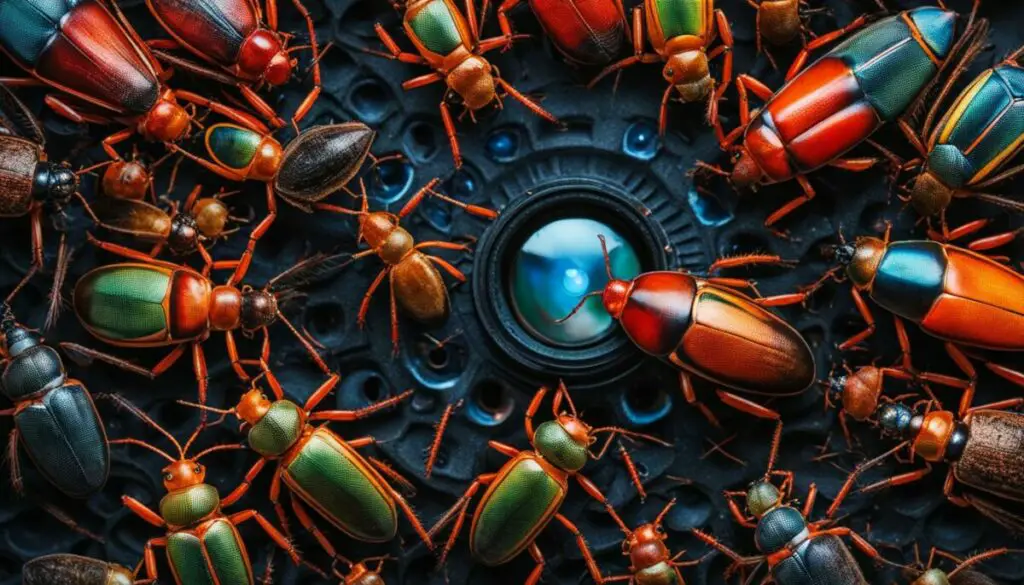
Bugs can pose challenges for security cameras, leading to obstructed camera lenses, blurry footage, and potential damage to camera housing. Insects are often attracted to the infrared light emitted by security cameras, mistaking it for a food source or heat. Additionally, bugs may build nests inside the camera housing, further compromising the camera’s performance.
To address these issues, it is essential to implement measures that prevent bug interference and maintain the optimal functioning of security camera systems. Physical barriers, such as mesh screens or insect netting, can be installed to prevent bugs from coming into direct contact with the camera lens. This helps ensure clear and unobstructed footage.
Regular cleaning and maintenance are crucial to remove any debris or dirt that may attract bugs and obstruct the camera lens. Using a blower or compressed air can help clear out any insects that may have entered the camera housing. By keeping security cameras clean and well-maintained, the risk of bug interference can be minimized, resulting in improved camera performance and clear video recordings.
Bug Prevention for Security Cameras
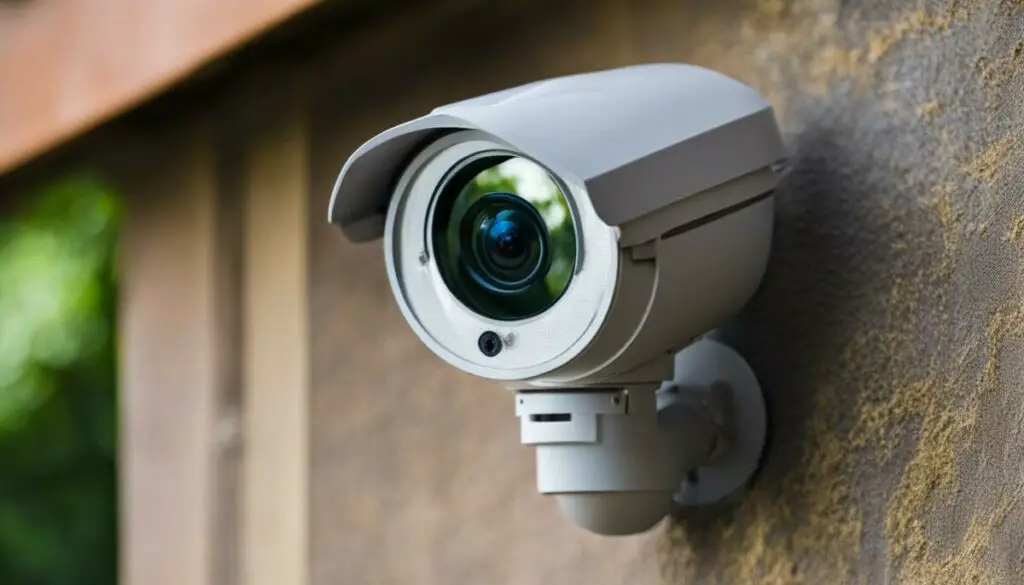
When it comes to ensuring the optimal performance of security cameras, bug interference can be a common challenge. However, there are several preventive measures that can be taken to keep bugs away from these important devices. Let’s explore some effective strategies for bug prevention and maintaining insect-free camera systems.
Physical Barriers
One way to deter bugs from approaching security cameras is by installing physical barriers. Mesh screens or insect netting can be placed around the cameras to prevent bugs from coming into direct contact with the lens. These barriers serve as a protective barrier while still allowing the camera to capture clear footage. By creating a physical barrier, bugs are less likely to obstruct the camera lens and impact the image quality.
Chemical Repellents
Chemical repellents can also be used as a bug prevention method for security cameras. Certain repellents are designed to deter bugs from approaching the cameras, reducing the likelihood of interference. It is important to choose repellents that are safe to use around electronic devices and follow the manufacturer’s instructions for proper application. By applying chemical repellents strategically, bugs can be discouraged from disturbing the camera’s functionality.
Artificial Lighting
Insects are often attracted to bright lights, so using artificial lighting can help deter bugs from approaching security cameras. By illuminating the area surrounding the cameras, bugs are more likely to be drawn to the light source rather than the camera itself. This can be achieved by installing additional lighting fixtures strategically around the property. Creating a well-lit environment can significantly reduce the attraction of bugs to the security cameras.
| Bug Prevention Methods | Effectiveness |
|---|---|
| Physical Barriers | Effective in preventing direct contact between bugs and camera lens |
| Chemical Repellents | Can deter bugs from approaching security cameras when used properly |
| Artificial Lighting | Reduces the attraction of bugs to the cameras by providing an alternate light source |
By implementing these bug prevention strategies and maintaining insect-free camera systems, the performance and reliability of security cameras can be optimized. Regular cleaning and maintenance, along with the use of physical barriers, chemical repellents, and artificial lighting, can ensure that bugs do not interfere with the functionality of these important devices.
Maintenance and Cleaning
Maintaining and cleaning security cameras is essential to ensure optimal performance and clear footage. Regular maintenance helps prevent bug interference and prolongs the lifespan of the camera system. Here are some key steps to consider:
1. Cleaning the Security Camera Lens
The camera lens can accumulate dirt, dust, and debris over time, which can affect the quality of the footage. To clean the lens:
- Gently remove any visible debris or dust particles using a soft, lint-free cloth.
- Apply a small amount of lens cleaning solution to the cloth and wipe the lens in a circular motion, starting from the center and moving outward.
- Use a dry part of the cloth to remove any excess cleaning solution.
2. Removing Debris from the Camera Housing
The camera housing can attract bugs and collect dirt, leaves, and other debris. Cleaning the housing helps prevent blockage and ensures proper ventilation. To remove debris:
- Power off the camera and disconnect any power supply.
- Use a blower or compressed air to gently blow away any loose debris or dust from the camera housing.
- Inspect the housing for any signs of bugs or nests. If found, use a soft brush or cloth to carefully remove them.
3. Regular Maintenance Checks
Performing routine maintenance checks can help identify any issues or malfunctions early on. Consider the following:
Regularly inspect the camera for signs of wear and tear, loose connections, or damaged cables. Check the camera’s firmware and software updates to ensure they are up to date.
By following these maintenance and cleaning practices, you can keep your security camera system in optimal condition, reduce bug interference, and ensure reliable surveillance and monitoring.
Conclusion
Bugs can be quite a nuisance when it comes to security cameras, but with some simple preventative measures and regular maintenance, their interference can be minimized. By implementing bug prevention strategies and maintaining insect-free camera systems, you can optimize the performance of your security cameras and ensure that they remain reliable in monitoring and protecting your property.
To prevent bugs from getting too close to your security cameras, consider using physical barriers such as mesh screens or insect netting. These barriers can effectively keep bugs away from the camera lens and prevent them from obstructing your footage. Additionally, you can use chemical repellents to deter bugs from approaching the cameras, further reducing the chances of interference.
Another effective method for bug prevention is to install additional artificial lighting around your property. This creates a more evenly lit environment and reduces the attraction of bugs to your security cameras. By keeping the area well-lit, you can discourage bugs from approaching the cameras in the first place.
Regular maintenance and cleaning are crucial to ensure that your security cameras remain insect-free. Clean the camera lens and housing regularly to remove any debris or dirt that may attract bugs. If bugs do manage to enter the camera housing, use a blower or compressed air to clear them out. By maintaining your security cameras, you can minimize the risk of bug interference and ensure optimal performance and clear footage.
FAQ
Can bugs see infrared?
While bugs may not have true infrared vision, they can still detect and respond to heat sources. Insects are attracted to warmth, which signifies potential food sources or breeding environments. Infrared radiation can serve as a cue for insects to guide their behaviors, such as foraging or mating. The extent to which insects can directly perceive infrared light is still a subject of ongoing research and debate.
How do insects perceive their environment?
Insects have complex visual systems that allow them to perceive and navigate their environment. They have compound eyes consisting of individual lenses called ommatidia. Each ommatidium detects a small portion of the visual field, and all ommatidia together form the insect’s overall vision. Insects can detect a wide range of wavelengths, including ultraviolet and visible light. Some insects can perceive thermal radiation and navigate towards heat sources.
Why are insects attracted to light?
Insects are attracted to light because they may mistake artificial lights, such as those emitted by security cameras, for natural light sources like the moon or the sun. Insects can be drawn towards light sources because they associate them with potential food sources or suitable breeding environments. This attraction to light is also utilized in light trapping methods for research or pest control purposes.
How do bugs interfere with security cameras?
Bugs can pose challenges for security cameras by obstructing the camera lens or creating blurred footage. Insects may be attracted to the infrared light emitted by security cameras, mistaking it for a food source or heat. They can also build nests inside the camera housing, potentially causing damage and impacting the camera’s performance.
How can bugs be kept away from security cameras?
There are several preventative measures that can be taken to keep bugs away from security cameras. Physical barriers, such as mesh screens or insect netting, can be installed to prevent bugs from coming into direct contact with the camera lens. Chemical repellents can also be used to deter bugs from approaching the cameras. Additionally, installing additional lighting around the property can create a more evenly lit environment and reduce the attraction of bugs to the security cameras.
How should security cameras be maintained to prevent bug interference?
Regular maintenance and cleaning of security cameras are essential to prevent bug interference. Cleaning the camera lens and housing regularly helps remove debris or dirt that may attract bugs. Using a blower or compressed air can help clear out any bugs that may have entered the camera housing. By maintaining and cleaning security cameras, the risk of bug interference can be minimized, ensuring optimal performance and clear footage.
What can be done to optimize security camera performance and minimize bug interference?
By implementing preventative measures such as physical barriers, chemical repellents, and additional lighting, bugs can be deterred from approaching security cameras. Regular maintenance and cleaning are also crucial to prevent bug interference. Taking these steps ensures that security camera systems remain reliable and effective in monitoring and protecting properties.

